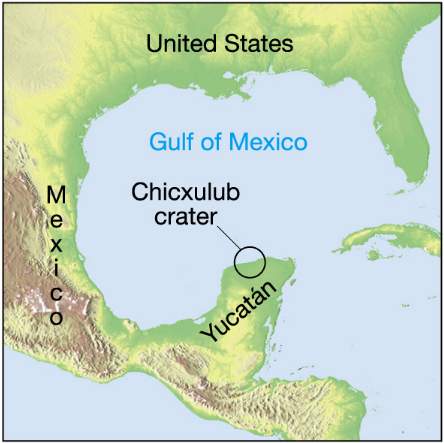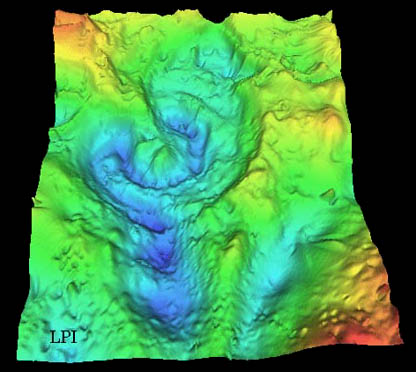The Crater
- Introduction
- Comets
- Asteroids
- Meteorites
- Meteor Showers
- Rock Types
- Identification
- Origins
- Destruction
The impact of a 10 km asteroid or comet must have produced a circular crater, probably more than a 150 km in diameter. A crater that size would probably have multiple ring structures, like the larger craters on the Moon. Although remnants of a few large craters matching this description are known on the Earth, they are all much older than the 65 million year age of the K-T boundary. The lack of a known crater made many scientists suspicious of the whole impact hypothesis, and inspired others to look for the impact crater. Many features around the world were suggested and investigated as possible impact sites.
The work centred initially on North America because the largest fragments of shocked rock were found there. The Manson meteorite crater, beneath Iowa, was first targeted because it formed about 65 million years ago. But Manson is only 35 km in diameter, probably too small to have caused global devastation and too small to have been made by a 10 km asteroid.

The search then moved to the Caribbean area, because the clay layer was thickest there, and had the largest rock fragments and globules of melted rock. Finally, suspicion focused on an unusual sub-surface structure on the northern coast of Yucatan (Mexico), centered under the town of Chicxulub. Studying rocks from drill cores of the area and data from remote sensing methods (gravity measurements, seismic profiles) showed that the Chicxulub structure is a meteorite impact crater.
Its current size is estimated at 180 km in diameter, certainly large enough to have caused a global environmental catastrophe. As the asteroid hit, all life within about 300 km would be vaporized instantly. Then the hot blast wave from the impact explosion would kill all life for several hundred kilometres in all directions. Further out, the blast wave would kill, deafen and disorient many animals. In the ocean, the shock from the impact would generate enormous, world-wide tsunamis (mega- tsunamis), perhaps with waves a kilometre tall. Gigantic hurricanes (hypercanes) might also be triggered. In the Earth, the shock from the impact would be felt as huge earthquakes, and would set off other earthquakes over the whole globe.

Ejecta from the impact (both sand-sized particles and larger) would shoot out and rain down for thousands of kilometres around. Other ejecta would leave the Earth’s atmosphere but not Earth’s gravity; it would return to Earth as meteorites so abundant that their heat would “broil” the Earth’s surface and set off wildfires over the whole planet. Over the impact site, a mushroom cloud would rise, carrying dust from the explosion far into the stratosphere. This dust would mingle with the soot from wildfires to form a world-wide haze so thick as to block out all light from the sun. Over time, without the Sun’s heat, surface temperatures on the Earth would drop 20-30°C.
The combined effects of the fires, the darkness, and the cold must have devastated life and caused the collapse of almost all ecological inter-relationships. Months later, when the dust cleared and the Sun finally shone again, only some seeds and the most enduring animals would still be alive. Three quarters of all species would die in the next few years, due to the loss of the ecosystems on which they depended. Early shrew-like animals were the only mammals so far discovered to have survived the disaster, and it is thought that birds may be the only direct descendant of the dinosaurs left living today.


